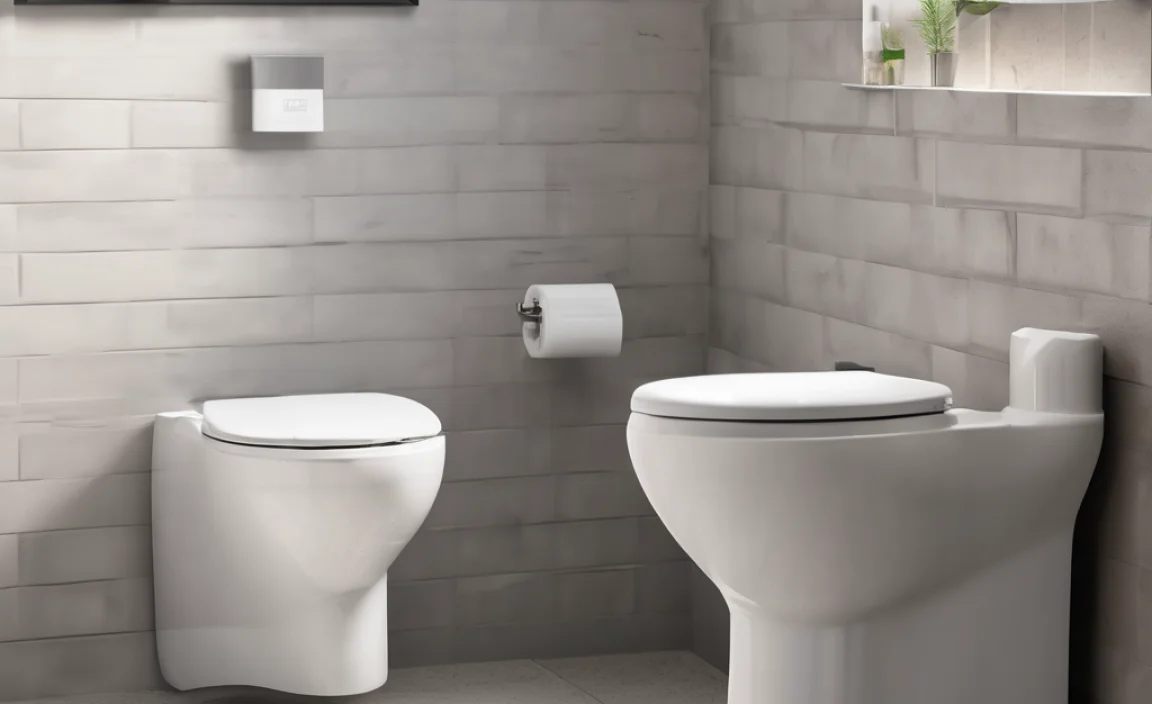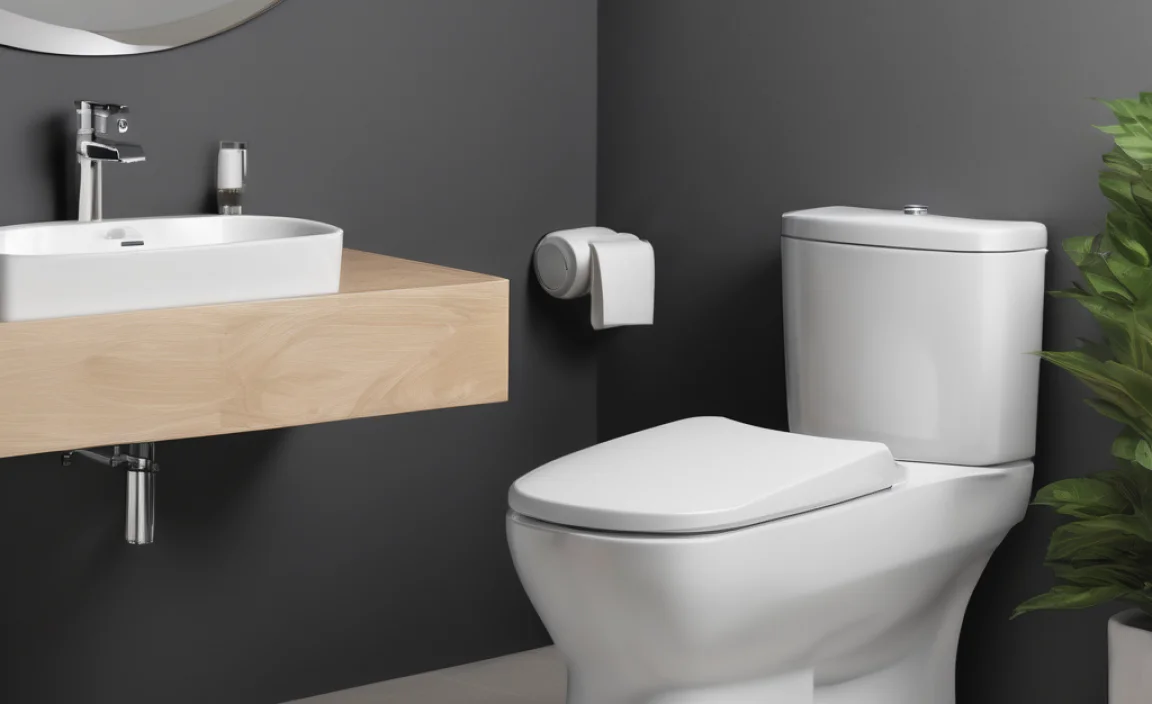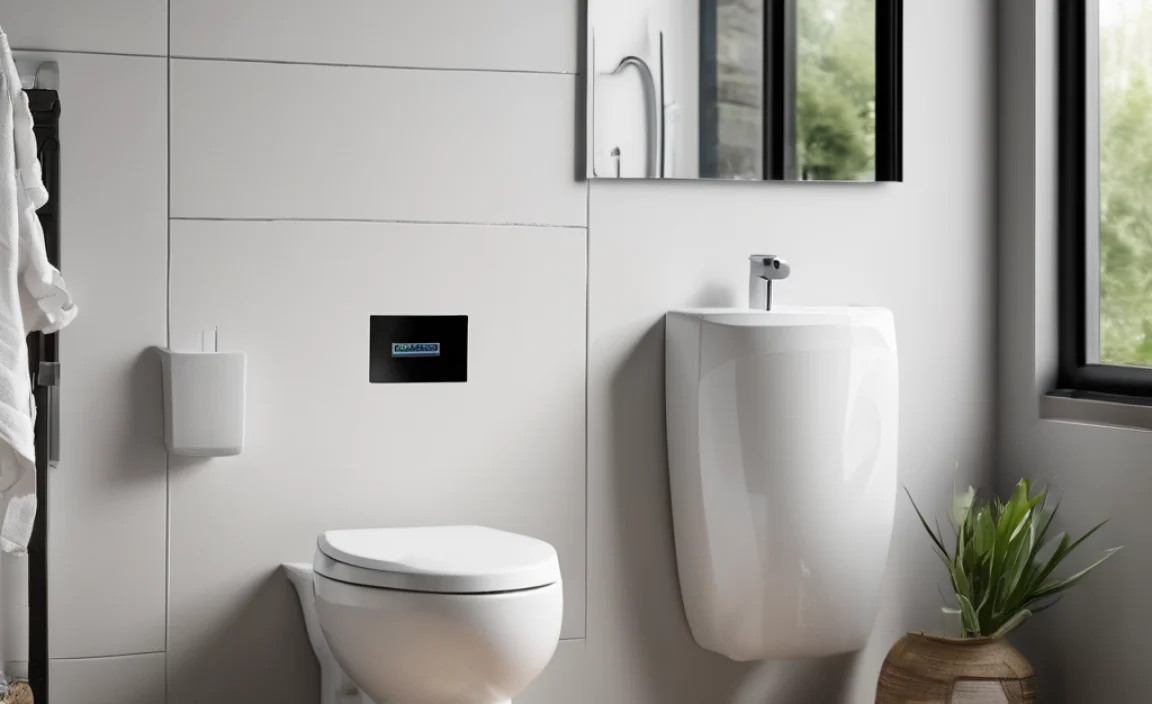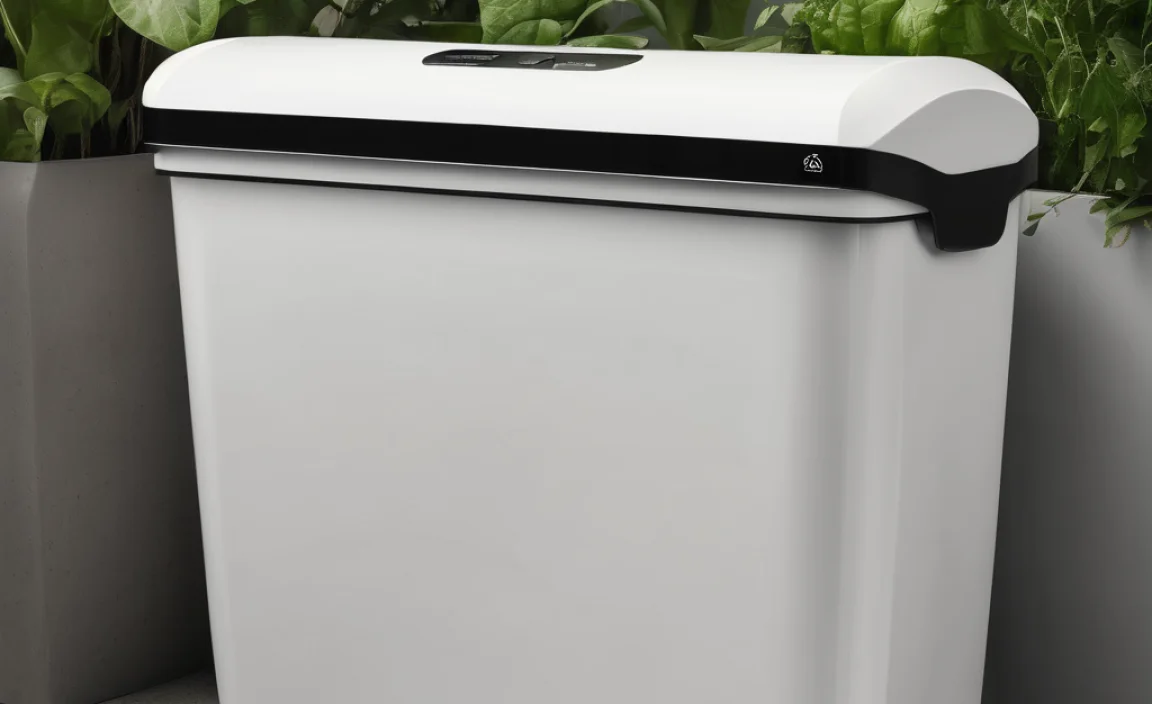Yes, dual flush toilets are worth it! They save water by letting you choose between a full flush for solids and a half flush for liquids. This reduces your water bill and helps the environment. While they might cost a bit more upfront, the long-term savings and eco-friendly benefits make them a smart choice for any home.
Ever wondered if switching to a dual flush toilet could actually make a difference? It’s a question many homeowners ask when trying to save money and be a little greener. Figuring out if the upfront cost is worth the long-term savings can be tricky.
Don’t worry, we’ve got you covered! In this guide, we’ll break down everything you need to know about dual flush toilets. We’ll look at how they work, the pros and cons, and whether they’re the right choice for your home. Plus, we’ll answer all your burning questions. Let’s dive in!
What is a Dual Flush Toilet?

A dual flush toilet is a type of toilet that gives you two options for flushing. Instead of just one handle or button, you get to choose between a full flush and a half flush.
The full flush uses the standard amount of water to get rid of solid waste. The half flush uses less water and is perfect for liquid waste and saving water. This simple change can really add up over time, reducing your water bill and helping the environment.
How Does a Dual Flush Toilet Work?
Dual flush toilets use a clever design to control how much water is used. Here’s a simple breakdown:
- Two Buttons or Levers: You’ll see two buttons on top of the tank or a dual-action lever on the side.
- Full Flush: Pressing the larger button or lifting the lever usually triggers a full flush. This opens the flush valve completely, releasing all the water in the tank.
- Half Flush: Pressing the smaller button or pushing the lever down activates the half flush. This only partially opens the valve, using less water.
- Internal Mechanisms: Inside the tank, there’s a special mechanism with a cylinder or flapper that controls the water flow. This mechanism is designed to release the correct amount of water based on which flush option you choose.
Benefits of Dual Flush Toilets

Switching to a dual flush toilet can bring many advantages. Here’s a closer look at the main benefits:
- Water Conservation: This is the biggest advantage. By using less water for liquid waste, you significantly reduce your overall water usage.
- Lower Water Bills: Saving water translates directly to savings on your water bill. Over time, these savings can really add up.
- Environmentally Friendly: Using less water helps conserve this precious resource and reduces the strain on your local water supply. It’s a simple way to make your home more eco-friendly.
- Modern Design: Dual flush toilets often come in sleek, modern designs that can update the look of your bathroom.
- Potential Rebates: Many local water companies offer rebates for installing water-efficient toilets, which can help offset the initial cost.
Potential Drawbacks of Dual Flush Toilets

While dual flush toilets have many benefits, there are also a few potential downsides to consider:
- Higher Upfront Cost: Dual flush toilets typically cost more than standard toilets. However, the long-term water savings can often make up for this difference.
- More Complex Mechanisms: The more complex design means there are more parts that could potentially break. However, with proper maintenance, this shouldn’t be a major issue.
- Potential for Clogging: Some older models of dual flush toilets may not have as powerful a flush, which could lead to clogs. However, newer models are designed to prevent this issue.
- Learning Curve: It might take a little time for your family and guests to get used to the dual flush system. Clear instructions can help with this.
Dual Flush vs. Single Flush Toilets

Understanding the key differences between dual flush and single flush toilets can help you make the best choice for your home. Here’s a simple comparison:
| Feature | Dual Flush Toilet | Single Flush Toilet |
|---|---|---|
| Water Usage | Uses less water; offers full and half flush options | Uses the same amount of water for every flush |
| Cost | Higher upfront cost | Lower upfront cost |
| Environmental Impact | More environmentally friendly due to water conservation | Less environmentally friendly due to higher water usage |
| Design | Often features a modern design | Can have a more traditional design |
| Maintenance | May require more maintenance due to complex mechanisms | Generally simpler to maintain |
Types of Dual Flush Toilets

Dual flush toilets come in various designs and styles. Here are some of the most common types:
- Dual Button Toilets: These have two buttons on top of the tank – one for a full flush and one for a half flush. They are easy to use and a popular choice for many homes.
- Dual Lever Toilets: Instead of buttons, these toilets have a lever on the side. Pushing the lever up usually triggers a full flush, while pushing it down activates a half flush.
- Concealed Tank Toilets: These toilets have the tank hidden behind the wall, giving a sleek, modern look. They often use a dual flush system with buttons or sensors.
- Wall-Hung Toilets: These toilets are mounted on the wall, making them easy to clean around. They typically use a dual flush system to save water.
How Much Water Can You Save?
One of the biggest reasons people switch to dual flush toilets is the potential for water savings. But how much can you really save?
A standard single flush toilet uses about 1.6 gallons per flush (GPF). Older models can use as much as 3.5 GPF or more! Dual flush toilets, on the other hand, use 1.6 GPF for a full flush and as little as 0.8 GPF for a half flush.
According to the EPA, the average person flushes the toilet about five times a day. If you replace a standard toilet with a dual flush model and use the half flush option for two of those flushes, you could save:
(2 flushes) x (1.6 GPF – 0.8 GPF) = 1.6 gallons saved per day
Over a year, this adds up to:
1. 6 gallons/day x 365 days/year = 584 gallons saved per year
For a family of four, that could mean saving over 2,336 gallons of water each year!
Installation Tips for Dual Flush Toilets
Installing a dual flush toilet is a manageable DIY project for many homeowners. Here are some tips to make the process smoother:
- Gather Your Tools: Make sure you have all the necessary tools, including a wrench, adjustable pliers, a screwdriver, a level, and a measuring tape.
- Read the Instructions: Carefully read the manufacturer’s instructions before you start. Each toilet model may have specific installation steps.
- Remove the Old Toilet: Turn off the water supply to the old toilet and flush it to empty the tank. Disconnect the water supply line and remove the bolts holding the toilet to the floor. Gently rock the toilet to break the wax seal and lift it off the flange.
- Prepare the Flange: Clean the flange and inspect it for damage. Replace it if necessary. Install a new wax ring on the flange.
- Install the New Toilet: Carefully position the new toilet over the flange, making sure the bolts line up. Press down firmly to create a good seal with the wax ring.
- Secure the Toilet: Tighten the bolts evenly, being careful not to overtighten them. Connect the water supply line to the toilet.
- Test the Flush: Turn the water supply back on and let the tank fill. Test both the full and half flush options to make sure everything is working correctly.
- Check for Leaks: Inspect around the base of the toilet and the water supply line for any leaks. Tighten connections as needed.
If you’re not comfortable with plumbing, consider hiring a professional plumber to install your new toilet. The EPA offers resources for finding qualified professionals.
Maintenance Tips for Dual Flush Toilets
To keep your dual flush toilet working efficiently and prevent problems, follow these maintenance tips:
- Regular Cleaning: Clean the toilet bowl regularly with a toilet brush and a mild cleaner. Avoid using harsh chemicals that could damage the toilet’s components.
- Check for Leaks: Periodically check around the base of the toilet and the water supply line for any leaks. Address any leaks promptly to prevent water damage and waste.
- Inspect the Flapper/Seal: The flapper or seal at the bottom of the tank can wear out over time, causing the toilet to run constantly. Inspect it regularly and replace it if necessary.
- Clean the Flush Valves: Mineral deposits can build up on the flush valves, affecting their performance. Clean them periodically with a vinegar solution to remove deposits.
- Avoid Flushing Inappropriate Items: Only flush toilet paper and human waste. Avoid flushing items like feminine hygiene products, diapers, and wipes, as they can clog the toilet and damage the plumbing.
Are Dual Flush Toilets Worth It: Cost Analysis
Let’s break down the costs involved in switching to a dual flush toilet to see if it’s a worthwhile investment.
| Cost Factor | Dual Flush Toilet | Single Flush Toilet |
|---|---|---|
| Initial Purchase Price | $150 – $500+ | $80 – $300 |
| Installation Cost (if hiring a plumber) | $100 – $300 | $100 – $300 |
| Water Bill Savings (per year) | $30 – $100+ (depending on water usage and rates) | $0 |
| Maintenance Costs (per year) | $10 – $30 (potential replacement parts) | $5 – $20 (potential replacement parts) |
As you can see, the initial cost of a dual flush toilet is higher. However, the water bill savings can add up over time, potentially offsetting the higher upfront cost. Additionally, many areas offer rebates for installing water-efficient toilets, which can further reduce the initial investment.
Break-Even Point
To determine if a dual flush toilet is worth it financially, calculate the break-even point. This is the point at which the water savings equal the difference in the initial cost.
For example, if a dual flush toilet costs $200 more than a single flush toilet and saves you $50 per year on your water bill, the break-even point would be:
$200 / $50 per year = 4 years
After 4 years, you would start saving money overall.
Styles and Design Options
Dual flush toilets come in a wide range of styles and designs to match any bathroom decor. Here are some popular options:
- Modern and Minimalist: These toilets feature clean lines, sleek shapes, and simple designs. They often have concealed tanks and wall-hung options for a contemporary look.
- Traditional and Classic: These toilets have a more ornate design with decorative details and a classic silhouette. They often feature a traditional lever handle.
- Compact and Space-Saving: These toilets are designed to fit in small bathrooms or powder rooms. They often have a smaller tank and a round bowl to save space.
- Smart Toilets: Some high-end dual flush toilets come with smart features like heated seats, automatic flushing, and built-in bidets.
When choosing a style, consider the overall aesthetic of your bathroom and your personal preferences. A well-chosen toilet can enhance the look and feel of your space.
Finding Rebates and Incentives
Many local water companies and government agencies offer rebates and incentives for installing water-efficient toilets. These programs can help offset the initial cost of a dual flush toilet and make it even more worthwhile.
Here’s how to find rebates and incentives in your area:
- Check with Your Local Water Company: Visit your water company’s website or call their customer service line to inquire about available rebates.
- Search Online: Use search engines to look for rebates and incentives in your city or state. The EPA’s WaterSense program also provides information on rebates and water-saving tips.
- Visit Your Local Government’s Website: Check the website of your city or county government for information on water conservation programs.
Rebates can range from $50 to $200 or more, depending on the program and the type of toilet you install. Be sure to apply for any available rebates before or after purchasing your new toilet.
Are Dual Flush Toilets Worth It? FAQs
1. Are dual flush toilets hard to install?
No, installing a dual flush toilet is similar to installing a regular toilet. If you’re comfortable with basic plumbing, you can do it yourself. If not, a plumber can help.
2. Do dual flush toilets clog more easily?
Older models sometimes had clogging issues. Newer dual flush toilets are designed with powerful flushes to prevent clogs.
3. How much water do dual flush toilets save?
Dual flush toilets can save up to 50% more water than standard toilets. The exact amount depends on how often you use the half flush option.
4. Are dual flush toilets more expensive to repair?
The parts can be a bit pricier due to the more complex design. But with regular maintenance, you shouldn’t need repairs often.
5. What is the average lifespan of a dual flush toilet?
With proper care, a dual flush toilet can last just as long as a regular toilet – typically 10 to 15 years or more.
6. Are there any downsides to using a dual flush toilet?
The main downside is the higher upfront cost. Some people might also find the dual flush system takes a little getting used to.
7. Can I replace my existing toilet with a dual flush model?
Yes! Replacing your old toilet with a dual flush model is a straightforward upgrade. Just make sure the new toilet fits your bathroom’s plumbing.
Conclusion
So, are dual flush toilets worth it? Absolutely! While they might cost a bit more upfront, the long-term benefits of water conservation, lower water bills, and environmental friendliness make them a smart investment for any home. With various styles and designs available, you can easily find a dual flush toilet that fits your needs and enhances your bathroom’s look.
By understanding how dual flush toilets work, their pros and cons, and how to install and maintain them, you can make an informed decision and enjoy the many benefits they offer. Start saving water and money today!


